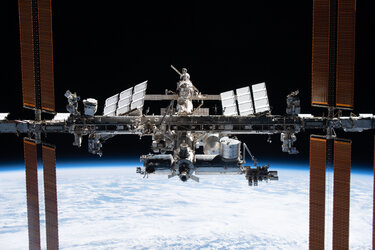Accept all cookies Accept only essential cookies See our Cookie Notice

About ESA
The European Space Agency (ESA) is Europe’s gateway to space. Its mission is to shape the development of Europe’s space capability and ensure that investment in space continues to deliver benefits to the citizens of Europe and the world.
Highlights
ESA - United space in Europe
This is ESA ESA facts Member States & Cooperating States Funding Director General Top management For Member State Delegations European vision European Space Policy ESA & EU Space Councils Responsibility & Sustainability Annual Report Calendar of meetings Corporate newsEstablishments & sites
ESA Headquarters ESA ESTEC ESA ESOC ESA ESRIN ESA EAC ESA ESAC Europe's Spaceport ESA ESEC ESA ECSAT Brussels Office Washington OfficeWorking with ESA
Business with ESA ESA Commercialisation Gateway Law at ESA Careers Cyber resilience at ESA IT at ESA Newsroom Partnerships Merchandising Licence Education Open Space Innovation Platform Integrity and Reporting Administrative Tribunal Health and SafetyMore about ESA
History ESA Historical Archives Exhibitions Publications Art & Culture ESA Merchandise Kids Diversity ESA Brand Centre ESA ChampionsLatest
Space in Member States
Find out more about space activities in our 23 Member States, and understand how ESA works together with their national agencies, institutions and organisations.
Science & Exploration
Exploring our Solar System and unlocking the secrets of the Universe
Go to topicAstronauts
Missions
Juice Euclid Webb Solar Orbiter BepiColombo Gaia ExoMars Cheops Exoplanet missions More missionsActivities
International Space Station Orion service module Gateway Concordia Caves & Pangaea BenefitsLatest
Space Safety
Protecting life and infrastructure on Earth and in orbit
Go to topicAsteroids
Asteroids and Planetary Defence Asteroid danger explained Flyeye telescope: asteroid detection Hera mission: asteroid deflection Near-Earth Object Coordination CentreSpace junk
About space debris Space debris by the numbers Space Environment Report In space refuelling, refurbishing and removingSafety from space
Clean Space ecodesign Zero Debris Technologies Space for Earth Supporting Sustainable DevelopmentApplications
Using space to benefit citizens and meet future challenges on Earth
Go to topicObserving the Earth
Observing the Earth Future EO Copernicus Meteorology Space for our climate Satellite missionsCommercialisation
ESA Commercialisation Gateway Open Space Innovation Platform Business Incubation ESA Space SolutionsLatest
Enabling & Support
Making space accessible and developing the technologies for the future
Go to topicBuilding missions
Space Engineering and Technology Test centre Laboratories Concurrent Design Facility Preparing for the future Shaping the Future Discovery and Preparation Advanced Concepts TeamSpace transportation
Space Transportation Ariane Vega Space Rider Future space transportation Boost! Europe's Spaceport Launches from Europe's Spaceport from 2012Latest

John McFall running on the Altered G Treadmill
Thank you for liking
You have already liked this page, you can only like it once!
John McFall, a former Paralympic athlete and orthopaedic surgeon, was selected as the first member of the European Space Agency's Astronaut Reserve with a physical disability in 2022. This marked a significant milestone in ESA’s Fly! initiative, which aims to enable a professional astronaut with a physical disability to join as a fully integrated crew member on a long-duration mission to the International Space Station (ISS).
With John’s selection, ESA entered the Feasibility Study phase of the Fly! initiative to address challenges associated with John’s specific type of disability (lower limb amputation).
On Earth, activities like sitting, standing, and walking place stress on the bones in the lower back, hips, and legs, helping to maintain their density and strength as we age. In space, the lack of gravity removes these stresses, causing astronauts' load-bearing bones to weaken much faster than they would on Earth. To counter this, astronauts use a specialised treadmill to simulate weight-bearing exercise in microgravity.
Amputees use prosthetic blades with specific stiffness for support during running. The Altered G (AlterG) Treadmill, often used for rehabilitation on Earth, mimics weightless conditions and was used in the Fly! Feasibility Study to identify the ideal blade stiffness for running on the ISS treadmill. Future parabolic flight tests will refine the stiffness and range of movement of the prosthetic knee to optimise running in microgravity.
-
CREDIT
ESA -
LICENCE
ESA Standard Licence

John McFall at SpaceX

Testing prosthesis fit in simulated microgravity

ESA portrait of John McFall

Space is not the limit















 Germany
Germany
 Austria
Austria
 Belgium
Belgium
 Denmark
Denmark
 Spain
Spain
 Estonia
Estonia
 Finland
Finland
 France
France
 Greece
Greece
 Hungary
Hungary
 Ireland
Ireland
 Italy
Italy
 Luxembourg
Luxembourg
 Norway
Norway
 The Netherlands
The Netherlands
 Poland
Poland
 Portugal
Portugal
 Czechia
Czechia
 Romania
Romania
 United Kingdom
United Kingdom
 Slovenia
Slovenia
 Sweden
Sweden
 Switzerland
Switzerland

























